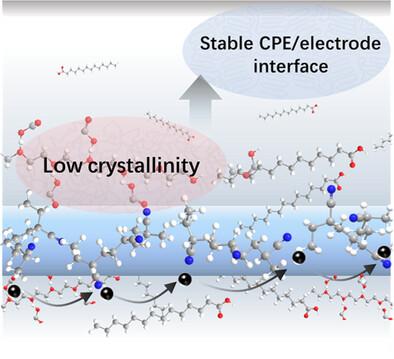相变有机小分子能够在室温下在全固态锂金属袋状电池中工作
IF 19
1区 材料科学
Q1 CHEMISTRY, MULTIDISCIPLINARY
引用次数: 0
摘要
聚环氧乙烷(PEO)基电解质在全固态锂电池(asslb)中显示出巨大的应用潜力。然而,解决无溶剂聚合物电解质的温度依赖性限制的有效策略仍然难以捉摸。在此,该研究开创了具有相变特性的有机小分子在全固态电池中的应用。提出了氢键诱导的结晶抑制和相变过程中的局部热环境影响。该效果基于结晶空间占用机制,通过常规蒸发结晶后的二次冷却结晶实现。富缺陷的PEO晶体结构是在优先结晶的相变材料肉豆蔻酸之间的密闭空间内诱导形成的。此外,在整个电解质中构建的肉豆蔻酸含量的空间梯度可以创建高非晶态区域和稳定的电解质/电极界面,从而实现锂离子的快速传输。因此,二次冷却结晶后的温度响应电解质表现出更高的离子电导率(在30°C时从7.20 × 10−5到1.23 × 10−4 S cm−1)和锂离子转移数。组装的全固态袋状电池具有稳定的循环性能,在35°C和室温下的放电比容量分别为152.1 mAh g - 1和106.5 mAh g - 1,平均库仑效率超过96%。这项工作促进了无溶剂asslb在常温下运行的发展。本文章由计算机程序翻译,如有差异,请以英文原文为准。

Phase‐Change Organic Small Molecules Enable Operation at Room Temperature in All‐Solid‐State Lithium‐Metal Pouch Cells
Poly(ethylene oxide) (PEO)‐based electrolytes exhibit huge potential for application in all‐solid‐state lithium batteries (ASSLBs). However, effective strategies to address the temperature‐dependent limitation of the solvent‐free polymer electrolytes remain elusive. Herein, this study pioneers the application of organic small‐molecule with phase‐change properties within all‐solid‐state batteries. The hydrogen bond‐induced crystallization suppression and localized thermal environmental influences during phase transition are proposed. The effect is based on a mechanism of crystallization space occupation, implemented through a secondary cooling crystallization following the conventional evaporation crystallization. The defect‐rich PEO crystal structure is induced within the confined spaces between preferentially crystallized phase‐change material myristic acid. Moreover, the constructed spatial gradient of myristic acid content within the whole electrolyte can create a high amorphous region and stable electrolyte/electrode interfaces, enabling rapid lithium‐ion transport. Consequently, the temperature‐responsive electrolyte after the secondary cooling crystallization exhibits enhanced ionic conductivity (from 7.20 × 10−5 to 1.23 × 10−4 S cm−1 at 30 °C) and lithium‐ion transference number. The assembled all‐solid‐state pouch cells demonstrate stable cycling with a discharge specific capacity of 152.1 mAh g−1 at 35 °C and 106.5 mAh g−1 at room temperature with average Coulomb efficiency over 96%. This work advances the development of solvent‐free ASSLBs for ambient‐temperature operation.
求助全文
通过发布文献求助,成功后即可免费获取论文全文。
去求助
来源期刊

Advanced Functional Materials
工程技术-材料科学:综合
CiteScore
29.50
自引率
4.20%
发文量
2086
审稿时长
2.1 months
期刊介绍:
Firmly established as a top-tier materials science journal, Advanced Functional Materials reports breakthrough research in all aspects of materials science, including nanotechnology, chemistry, physics, and biology every week.
Advanced Functional Materials is known for its rapid and fair peer review, quality content, and high impact, making it the first choice of the international materials science community.
 求助内容:
求助内容: 应助结果提醒方式:
应助结果提醒方式:


